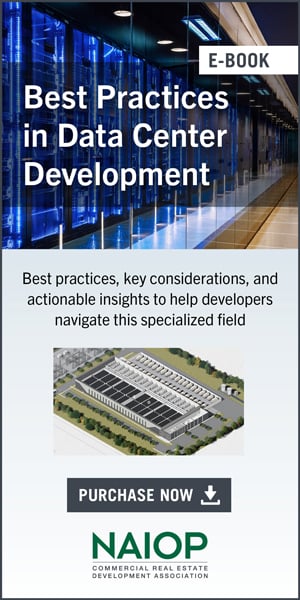Ten Industrial Trends to Watch

Industry experts discuss trends that will impact industrial facilities in 2018 and beyond.
AS THE LONG AND steady industrial growth cycle continues, a number of key trends regarding industrial properties emerged at NAIOP’s I.CON ’17: Trends and Forecasts conference in Long Beach, California in June.
1) City halls across North America need to focus on the need for last-mile industrial facilities within their jurisdictions. Ben Conwell, senior managing director and practice leader, ecommerce & electronic fulfillment, Cushman & Wakefield, and Larry Kosmont, president and CEO of Kosmont Companies, both addressed the concern that local officials have not yet done so.
“Cities are being forced by [states] to focus on greenhouse gas emissions,” said Kosmont. When cities look at accelerated truck deliveries within their boundaries, last-mile delivery seems, on the face of it, to be taking cities in the opposite direction of where they need to be, he noted. At the moment, cities are focused on retail, placemaking, mixed-use development and transit. They do not seem to understand that last-mile industrial facilities are part of a new retail paradigm that includes e-commerce.
Cities that do take a closer look at modern warehouse and distribution centers are finding a lot to like, according to Mike McCrary, managing director, industrial services, JLL. McCrary noted that Ontario Mills Mall in Ontario, California, attracts more visitors each year than Disneyland. Although the mall produces an estimated $6 million in tax revenue for the city, $4 million of that probably pays for police, fire protection and other expenses related to the mall – costs that an industrial facility would not generate – for a net of $2 million.
“The city of Ontario recently rezoned 200 acres of land just north of the airport [for industrial use],” McCrary added. “With a stroke of the pen, QVC signed a lease on a 1 million-square-foot building there. From the sales generated at the building, the city will get about $5 million in tax revenue.” He stressed that the industrial building increases the tax base for the city without appreciably adding to the cost of police and fire protection.
2) Urban warehouses are becoming “the new retail.” The classic method of conducting a retail market study has been to count rooftops; that is, the number of residential units in a targeted geographic area. Now, developers of and investors in urban infill industrial projects are also counting rooftops when building or buying new infill industrial facilities, underscoring the fact that these developments are becoming the new retail. Gray Bouchillon, president and chief investment officer, Evergreen Industrial Properties, said: “It’s about diving in at that granular level and knowing the market we want to be in: Who is our base? Not just the user base, but the consumer base. We’re constantly asking ourselves: where are the rooftops? Who are we distributing to?”
3) Differentiate between “good” and “bad” retail real estate. Chris Riley, vice chairman of CBRE, asked a panel addressing the capital markets about opportunities to replace or remake obsolete retail into last-mile facilities. Dayton Conklin, director, Clarion Partners, responded that his firm is assessing a mall it owns in the Northeast for this type of transition. Scott Strauss, executive director, JP Morgan Asset Management, however, offered words of caution about such undertakings: “Bad real estate is bad real estate,” he asserted. “A lot of retail that is falling apart right now should never have been developed in the first place. People think that retail is getting crushed today, but it is the bad retail that is getting crushed today; A-class retail is doing very well.”
4) Institutional investors may need to lighten up on due diligence to secure industrial properties owned or developed by smaller firms. Strauss added that sellers of well-located small industrial facilities are often “scared off” by the due diligence that the institutional buyer undertakes. “Sellers of this type of space tend to not be institutional and quite frankly we scare them away with our due diligence standards and some of the contract requirements, [which can be] 80 pages long. We understand that to grow our industrial book, we need a DNA change.”
5) The best secondary and tertiary markets for industrial space are shifting. Evergreen’s Bouchillon likes the fundamentals of Charlotte, North Carolina. David Levine, principal, The Blackstone Group, looks for secondary and tertiary industrial markets in geographies with good weather, because it suggests better population growth and job growth. He recommends the Gulf Coast Southeast. JP Morgan’s Strauss points to central Florida and Charlotte. Conklin of Clarion Partners likes Las Vegas and Nashville, and noted that Nashville has quickly grown from a market of 50,000- to 100,000-square-foot tenants to one with 400,000- to 600,000-square-foot tenants.
6) Multistory warehouses of three or more stories will start to rise on expensive infill sites. In expensive infill markets like Southern California, single-story warehouse structures will no longer generate enough income to justify the investment. Jay Todisco, AIA, LEED AP, executive vice president, Ware Malcomb, reported that while his firm is designing multilevel industrial projects for a dozen developers around the U.S., it has discovered that two-story facilities won’t perform much better than single-story ones. Urban infill industrial structures need to be at least three stories high to make sense financially.
John Pharris, president, CapRock Partners, LLC, pointed out that North American developers and investors need to look to Asia, where land constraints long ago forced companies to erect multistory warehouses. Some of those structures now rise as high as 11 stories, he added.
7) The pendulum is swinging from distribution back to manufacturing. The advent of the 3-D printer will shift the current emphasis on distribution back to manufacturing, predicted Gregory Healy, executive managing director, supply chain and logistics, Colliers International. He predicted that consumers will soon be able to order products that will be manufactured locally on a 3-D printer and then delivered to their doors, which will reduce inventories and speed delivery, much as e-commerce has done. Healy added that Amazon is seeking a patent on a vehicle that will collect orders, manufacture products and then deliver them directly to the customer.
8) A shortage of qualified employees is presenting challenges for industrial tenants. Finding skilled employees who can pass a drug test is becom-ing increasingly difficult. JLL’s McCrary said that industrial tenants are asking four questions when considering a new location: 1) Where do prospective employees live? 2) Can they pass a drug test? 3) Are they bilingual? 4) Can they operate the forklift’s computer?
9) Hybrid distribution/fulfillment centers will both deliver goods to consumers and replenish inventory in stores. Curtis Spencer, president, IMS Worldwide, Inc., described a new REI fulfillment center in Goodyear, Arizona, from which the company delivers products to online customers as well as to stores. In a typical warehouse, he noted, “you have pallets [coming] in and cartons [going] out to stores.” In a typical fulfillment center, products arrive on pallets and single items are shipped out to customers. REI is using its Goodyear facility “to ship products to its customers as well as to its stores.”
“This is new,” added Spencer. “It’s brilliant.” He predicted that other retailers will follow REI’s lead.
10) Closing the exports “value gap” will be critical for the U.S. economy. The nation needs to build export infrastructure if it hopes to close the yawning “value gap,” noted Walter Kemmsies, Ph.D., managing director, economist and chief strategist, JLL Ports, Airports and Global Infrastructure.
According to Kemmsies, the U.S. needs to realize it is now part of a global economy. “We import consumer goods, which have a high value per ton, and we export industrial goods, which have a low value per ton.” Tonnage wise, the U.S. is almost balanced, he explained, but value wise, it’s not even close.
“The real tragedy of all of the investment we’ve made in our port industry is that we export almost as many empty containers as we do loaded containers,” he asserted. “Something is wrong here. The White House complains that trade agreements are causing a trade deficit. As a logistics person, what I see is that America is the only country that signs trade agreements and then doesn’t invest in export-oriented infrastructure.”
Ron Derven, contributing editor, and Margarita Foster, editor-in-chief, Development




